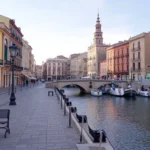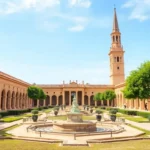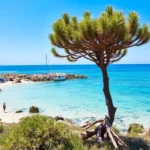10 Best Things to See and Do in Guayaquil
Are you looking to discover the best things to see and do in Guayaquil? This vibrant city on the Pacific coast has much more to offer than meets the eye. It was our final stop on a road trip through Ecuador and the starting point of our exciting adventure to the Galapagos Islands. While our minds were elsewhere, we found that Guayaquil has some interesting attractions for those willing to spend a couple of days exploring.
Initially, we arrived with low expectations; the stunning landscapes of inland Ecuador had set a high bar. Moreover, Guayaquil has a reputation for being the most dangerous city in Ecuador, often associated with corruption. However, we were pleasantly surprised to find it dynamic and vibrant, filled with colorful neighborhoods, parks teeming with iguanas, and much more than just a “gateway to the Galapagos.” Although Guayaquil didn't win us over completely, it’s still worth a visit. If you need to shorten your Ecuador itinerary, Guayaquil might be the place to cut.
Without further ado, here are the must-visit places in Guayaquil.
* As always, we provide plenty of useful information at the end of this article to help you plan your visit.
While many come here primarily to catch a flight to the Galapagos paradise, spending a day in Guayaquil can be quite rewarding. Ready to dive deeper into what Guayaquil has to offer? Let’s go!
Must-See Attractions in Guayaquil
1. Malecón 200
This boulevard stretches along the Guayas River for about 2 kilometers and is a favorite spot for both locals and tourists. Along this promenade, you’ll find bars and restaurants, gardens, fountains, playgrounds, and iconic monuments like the Hemiciclo de la Ronda, featuring Simón Bolívar and San Martín.
The entire area is well-secured (it closes at night) and has a strong police presence, making it one of the safest places to stroll in Guayaquil.
Interesting fact: The Hemiciclo de la Ronda commemorates the “Interview of Guayaquil,” a meeting between South American independence leaders José de San Martín and Simón Bolívar in July 1822.
2. Parque de las Iguanas
Officially known as Parque Seminario, this small park is affectionately termed the "Park of Iguanas" for a good reason: these creatures roam freely, large and small, fat and thin. Moreover, the park features tropical plants, a pond, parrots, pigeons, and turtles, creating a unique oasis in the bustling city.
This area was once the most important square in colonial times, known as the Plaza de Armas, though little remains of those days apart from the cathedral we’ll discuss next.
3. Cathedral of Guayaquil
Claiming to be one of the few colonial buildings still standing might be a bit misleading. The original cathedral, built in 1547, was destroyed by fire in 1692. A new Gothic-style church was constructed in the 20th century, which is what you can see today.
While Ecuador boasts other impressive cathedrals, such as those in Quito and Cuenca, Guayaquil’s cathedral stands out for its ornate towers, central rose window, and stunning stained glass windows inside.
If you only have one day in Guayaquil and want to make the most of it, consider hopping on a tour bus that takes you to all the major tourist spots quickly. It's affordable too!
4. Plaza de la Administración
This monumental urban space should be the starting point of your visit to downtown Guayaquil. It’s a hub of two pedestrian streets surrounded by impressive buildings like the University of the Arts, the Municipal Palace, and the Governor's Palace.
As you stroll, you can admire notable sculptures, including the Sculptural Ensemble of the 6 Virtues (Fortitude, Solidarity, Valor, Liberty, Leadership, and Generosity), each standing 2.20 meters tall, and monuments like the Furnace of Vulcan and the monument to Marshal Antonio José de Sucre.
5. Las Peñas, a must-see in Guayaquil
Nestled at the foot of the Santa Ana Hill, Las Peñas is the oldest and certainly the most colorful neighborhood in Guayaquil. One of the city’s most iconic images features its irregularly shaped, brightly colored houses.
It dates back to the 16th century when fishermen and artisans settled here. Later, affluent families built beautiful colonial-style houses, earning it the title of a cultural heritage site of Ecuador.
With a rich bohemian and cultural history, this area has attracted famous figures like Ernest Hemingway, Pablo Neruda, and Che Guevara. Today, you can still sense that spirit in its taverns and shops, some featuring live music.
The best way to explore this picturesque neighborhood is by ascending the “Diego Noboa” staircase, leading you to the next destination...
6. Santa Ana Hill
Climbing Santa Ana Hill is a rewarding endeavor. Starting from step number one, you’ll need to conquer 444 steps to reach what is arguably the best viewpoint in Guayaquil.
At the top, you’ll find the quaint yellow Chapel of the Virgin of Mercy and a beautiful lighthouse adorned with blue stripes representing the flag of Guayaquil. The panoramic views are breathtaking, especially at sunset.
7. Ride the Perla, one of the best experiences in Guayaquil
You don’t have to climb too high to enjoy stunning views of the city. Did you know Guayaquil is home to the largest Ferris wheel in South America? Known as “La Perla,” it reaches a height of 57 meters.
From this vantage point, you can gaze upon the Malecón, the city of Guayaquil, and the Guayas River. The price for a ride is just $3.50 (Monday to Friday) and $5 (Saturday and Sunday).
8. Torre The Point
However, this isn’t the tallest point in the city. To the north of Las Peñas, in the financial district, stands the Torre The Point, a modern spiral-shaped skyscraper that reaches nearly 137 meters high. Since its inauguration in 2013, it has become the tallest building in the country.
On the top floor, you’ll find the Club The Point Sky Bar, where you can sip a drink while enjoying breathtaking views of the river and the city.
9. Museums to visit in Guayaquil
Are you a museum lover? Do you have plenty of time? Looking for activities in Guayaquil if it rains? Here are four recommended museums where you can spend a few hours:
- Municipal Museum, featuring archaeological pieces in the pre-Hispanic room and historical artifacts in the colonial room.
- Anthropology and Contemporary Art Museum (MAAC), showcasing thousands of archaeological pieces that narrate Ecuador's history, as well as a significant collection of modern art.
- Nahim Isaías Museum, which aims to promote colonial art with its extensive exhibition of paintings and sculptures from the 16th to the 19th centuries, alongside modern and contemporary artwork.
- Barcelona and Emelec Shipyard Teams Museum, a free museum for football enthusiasts, chronicling the history of the two most popular local clubs originating from the Astillero neighborhood.
10. Feast on crab
We didn’t know it before arriving, but Guayaquil is famous for its creole crabs, one of the most popular dishes, especially along the coast. Where to try it? One of the best restaurants to savor this delicacy is La Pata Gorda.
More things to do and see in Guayaquil
In addition to these plans, Guayaquil offers other activities if you still have room in your itinerary. Here are our suggestions:
- Explore the Isla de Santay National Recreation Area, a paradise for birdwatching enthusiasts. It’s ideal to rent a bike and leisurely traverse its trails. Nearby, you’ll also find the lively Caraguay Market, where you can enjoy delicious meals for very little money.
- Another site to check out in Guayaquil is the Historical Park, which is unique for its divided areas, especially the one featuring traditional houses that have been rescued and relocated there. You can sign up for a comprehensive tour.
- Upon arriving in the city from the airport, you’ll spot a gigantic monkey statue right before entering the Santa Ana Port Tunnel. This is the “Mono Machín,” created using cement, iron, and over 100,000 ceramic pieces. It’s quite a sight to behold!
- Consider taking a mini-cruise on the Guayas River if you wish to see the city from the water. You can book it directly at Malecón 2000 for about $4.
- Alternatively, cross it by air in the Guayaquil Aerovia, a new cable car connecting Guayaquil and Durán, marking the first aerial transportation service in Ecuador.
Useful Information
As we mentioned, here are some recommendations to help you better organize your visit to Guayaquil:
› Where to stay
The best and safest area to stay in Guayaquil is around Malecón 200. We booked at Guesthouse Manso Boutique, a cozy hostel right on the Malecón with both private and shared rooms, slightly worn but with a great atmosphere and reasonable prices.
Other recommended accommodations in Guayaquil include the Hotel Ramada (with a pool!) and Pepe’s House (excellent value for money).
› How to get there and getting around
We arrived in Guayaquil by bus from Cuenca, taking the route through El Cajas. The journey lasts about four hours, with some winding roads, costing around $10. The main bus terminal (Terminal Terrestre) is located next to the airport, about 7 km north of the Malecón area. We opted for a taxi to get there, which cost us $4.
Map of places to see in Guayaquil
Finally, here's a map showing the locations of must-visit spots in Guayaquil:
Have we missed any essential things to see and do in Guayaquil? Let us know in the comments!
Follow our daily adventures in Ecuador on our Instagram stories
| Save on your trip |
| Find cheap flights to Ecuador here |
| Discover accommodation at the best prices here |
| Book activities in Spanish in Ecuador here |
| Get a 5% discount on your travel insurance with IATI here |
| Reserve airport transfers here |
| Learn how to withdraw money without fees here |
| Get a 5% discount on your eSIM with Holafly here |
| Rent a car with the best deals here |
| The best books and travel guides here |
| All our articles about Ecuador |



Deja una respuesta